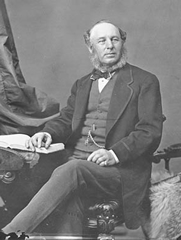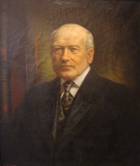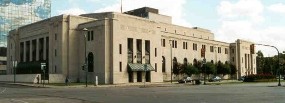About Us
-
Library History
-
Legislative Library Act
-
Library Mission Statement
As Manitoba's oldest library and as one of the major resource libraries in the province, the Legislative Library continues its mission to serve the citizens of Manitoba by promoting and preserving knowledge of the province's published heritage.

(enlarge)
The Legislative Library was established by Manitoba's first Lieutenant-Governor, A. G. Archibald. Before leaving Ottawa to assume his new duties, Archibald enlisted the help of Alpheus Todd, Parliamentary Librarian, in purchasing publications that would support the work of the new Legislative Assembly. Although he had originally planned to place this library in the Lieutenant-Governor's residence, Archibald decided to make it the nucleus of a Provincial Library and had the books placed in the Government Offices instead.
1870-1884: The early years:
After his arrival Archibald learned of a much older book collection, the Library of the Red River Settlement. Founded by Lord Selkirk, this library had originally been used by the Red River Settlers. These books were purchased from a local citizen who had been storing them in his home.
Bernard R. Ross was appointed Provincial Librarian, succeeded by Felix Trudel and George Roy. These men all had other duties to perform, however, and it was not until 1884 that John Palmerston Robertson was appointed the province's first Legislative Librarian.
1884-1919: The Robertson era:
With a background in teaching, studies in law and journalism, Robertson brought to his new career as a librarian qualities of intelligence, imagination, enthusiasm and tenacity, all of which would be needed to establish the first Legislative Library in the prairie provinces. Robertson soon discovered that some of the Library's collection had disappeared, and his indignation rings through his first Annual Report to the Legislature. Advertising in local newspapers, he called for the return of these books and published a set of rules for Library visitors. Reflecting the times, these rules governed circulation of books as well as establishing correct behaviour in the Library. Smoking, spitting on the floor and the presence of dogs in the Library were strictly forbidden.

(enlarge)
Over the next 35 years, Robertson built up the Library's collections of books and government publications, established exchange agreements with other libraries and governments and promoted the Library's role as a collector of published and unpublished records of the province's history. He established the Provincial Archives as well as a map and museum collection and planned for the Library's new quarters in the Legislative Building. Sadly, Robertson died before the move took place in 1919.
1919-1936: The Healy years:
Robertson was succeeded by W. J. Healy, another former journalist. Healy built up the Library's collections in the social sciences and economics and introduced the use of a card catalogue replacing the earlier system of book catalogues. During the Depression, budgets, and subscriptions to newspapers were cut and some Library staff dismissed. However, the Library's collections continued to grow due to the exchange agreements established with other libraries and institutions as well as provision in the Provincial Library and Museum Act of 1919 requiring that all Manitoba publications be deposited with the Library. This program, known as legal deposit continues under the authority of the current statute, The Legislative Library Act, which enables the Library to collect and preserve a research collection of Manitoba publications. Healy retired in 1936.
1936-1955: The Johnson years:
After Healy's retirement, John Leslie Johnston was appointed Librarian. Under his leadership, the Library's collections continued to grow and expand. More importantly, because of his interests in how libraries could contribute to post-war planning and renewal, and how library services were needed for the rural areas of Manitoba, the Legislative Library assumed a role as Provincial Library. By participating in local community groups such as the Manitoba Historical Society, Johnston encouraged greater use of the Library by university faculty members, students and the general public.
The post-war years saw the beginnings of several cooperative projects among Canadian libraries. Newspapers, especially the weeklies produced in towns throughout the province, had always been an important part of the Legislative Library's collections. In 1947, these were microfilmed by the Canadian Library Association in order to preserve a record of these early regional publications throughout the country. Johnson passed away in early 1955.
1955-1970: The Morley years:
After Johnson's death, Marjorie Morley, the first professionally-trained Legislative Librarian was appointed Provincial Librarian and Director of Library Services. Her new title reflected the Library's continuing role in promoting library services throughout the province. She continued the microfilming of the Library's collection of community newspapers. These were consulted regularly by researchers and historians compiling histories of those communities throughout the province who were celebrating their 50th and 75th anniversaries during this period.
1970-1988: Location, Location, Location!
In 1970, Ms Morley was succeeded by Clementine Combaz, whose career with the Library had begun in 1941. Under her leadership, the Library began to move in a new direction to serve the information needs of its patrons and of other libraries by publishing the Manitoba Government Publications Monthly Checklist and the Selected New Titles, which both continue to be published to this day.

(enlarge)
By the early 1970's, the Library as well as the Provincial Archives had long exhausted their storage space on three levels of the Legislative Building. Books and documents were so crowded that retrieval became almost impossible. In 1970, a solution was proposed when the Province of Manitoba purchased the Winnipeg Auditorium. Renamed the Manitoba Archives Building, this new facility was converted over a period of three years. Moving and reorganizing the Library's collections proved to be a formidable task but, in September of 1975, the new building was officially opened.

(enlarge)
Able to look back on a distinguished career dedicated to library users throughout the province, Miss Combaz retired in 1981, succeeded by Joyce Irvine. After the move to the Manitoba Archives Building, the Library continues to provide service in two locations. The Reading Room on the second floor of the Legislative Building was renovated in 1982-83. Restored to its gracious appearance evident in photographs taken in the 1920's, the Reading Room became the main service point for Members and staff of the Legislative Assembly. Extensive renovations to the Archives Building also took place during this period, creating much-needed stack and office space. As the Library celebrated its 100th anniversary in 1984, the staff could look back proudly on 100 years of service to Manitoba citizens.
In the 1980's, the library was an active partner in the National Library of Canada's Decentralized Newspaper Program, working with the Manitoba Library Association to establish a directory of Manitoba newspapers.
1988-2010: The Bishop years
In 1988, Susan Bishop became Manitoba's seventh Legislative Librarian. The late 1980's and early 1990's saw the library adopt new technologies available for services and ongoing operations including electronic mail, online retrieval, and specialized database development, leading up to the implementation of the Library's integrated catalogue. These new technologies offered the opportunity to expand the Library's services to Members of the Legislative Assembly, government personnel and the general public.
The Legislative Library was an early presence on the Manitoba Government's website, offering its Monthly Checklist of Government Publications electronically in 1995 and pioneering electronic reference through the corporate Website's Answer Desk in 1996. Technology has become an integral part of service delivery at the Library, as staff members routinely answer requests for information by e-mail and use Web-based or commercial online sources as an extension of traditional reference collections.
Current
In spring 2011, Tannis Gretzinger became the eighth Legislative Librarian. She retired in spring 2014. Since that time, Scott Goodine, Provincial Archivist, has been the Acting Legislative Librarian.
Since its earliest days, the library has worked collaboratively with other libraries in the province. Following the national library's regional meetings on resource sharing, the Legislative Library became one of the founding members of the Manitoba Library Consortium, an organization that now has more than 80 members.
Under The Legislative Library Act, S.M. 2008, c. 12, the library collects and preserves the print and electronic versions of documents published by Manitoba government departments, agencies, boards, commissions and independent offices of the Legislative Assembly, as well as publications from Manitoba's book, magazine and newspaper publishers. In this way, the library provides access to the documentary heritage of the province and ensures the ongoing preservation of this information for future generations of Manitobans.
The Legislative Library serves the Legislative Assembly, government and people of Manitoba. Under The Legislative Library Act, S.M. 2008, c. 12, the library collects, preserves and makes public materials available to our clients. Through these efforts, the library is able to share the province's rich informational resource and build a knowledge base for the future.
Every month, the library lists all new Manitoba published government documents received in the month in the Manitoba Government Publications Monthly Checklist.
The Legislative Library supports the conduct of public affairs and the development of a well-informed society by providing efficient, effective, and impartial access to specialized information resources for the Legislature, government, and people of Manitoba, and ensures current and future access to Manitoba's published heritage.


